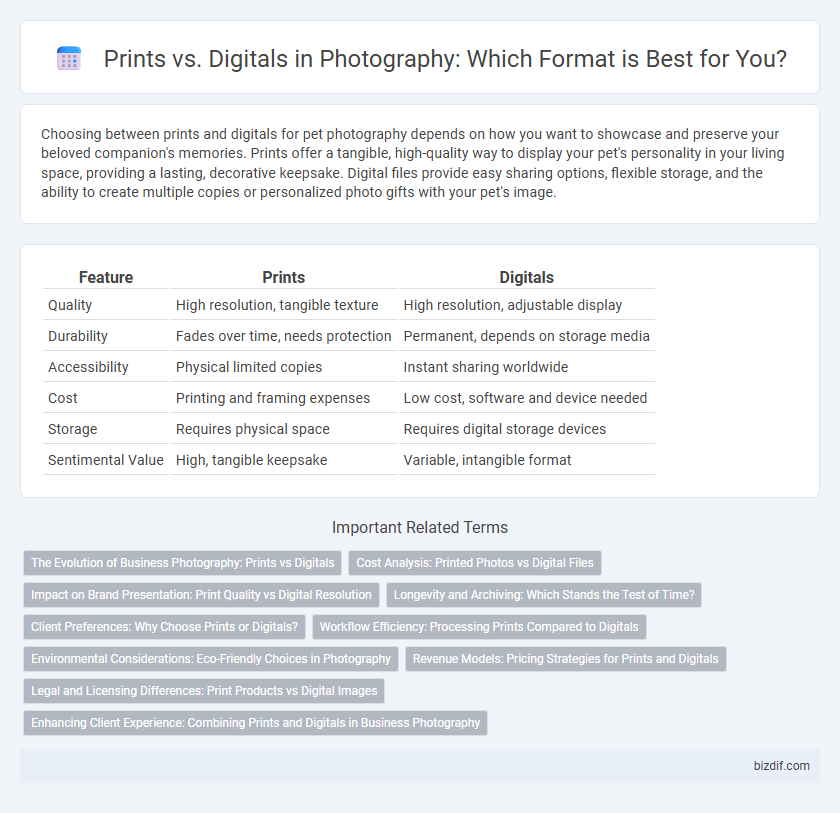Choosing between prints and digitals for pet photography depends on how you want to showcase and preserve your beloved companion's memories. Prints offer a tangible, high-quality way to display your pet's personality in your living space, providing a lasting, decorative keepsake. Digital files provide easy sharing options, flexible storage, and the ability to create multiple copies or personalized photo gifts with your pet's image.
Table of Comparison
| Feature | Prints | Digitals |
|---|---|---|
| Quality | High resolution, tangible texture | High resolution, adjustable display |
| Durability | Fades over time, needs protection | Permanent, depends on storage media |
| Accessibility | Physical limited copies | Instant sharing worldwide |
| Cost | Printing and framing expenses | Low cost, software and device needed |
| Storage | Requires physical space | Requires digital storage devices |
| Sentimental Value | High, tangible keepsake | Variable, intangible format |
The Evolution of Business Photography: Prints vs Digitals
The evolution of business photography highlights a shift from traditional prints to digital imagery, driven by advancements in technology and changing client demands. Digital photography offers immediate accessibility, cost efficiency, and enhanced editing capabilities, transforming marketing and branding strategies across industries. Despite the convenience of digitals, printed photographs remain valued for their tangible quality and lasting impression in professional settings.
Cost Analysis: Printed Photos vs Digital Files
Printed photos incur costs for materials like photo paper, ink, and physical storage, often resulting in higher expenses per image compared to digital files. Digital photos eliminate printing and shipping costs, offering affordable storage solutions through cloud services or external drives, making them a cost-efficient choice for large collections. While printed photos provide tangible value and display options, digital files optimize budget management by minimizing recurring expenses.
Impact on Brand Presentation: Print Quality vs Digital Resolution
High-quality prints offer tactile engagement and vibrant color accuracy that enhances brand perception, while digital resolution provides flexibility and instant accessibility for diverse platforms. Print quality ensures consistent visual impact in physical environments, reinforcing brand trust through durability and premium texture. Digital resolution excels in dynamic content delivery, optimizing brand presence across screen-based media with scalable detail and interactive potential.
Longevity and Archiving: Which Stands the Test of Time?
Prints offer tangible longevity with archival-quality papers and inks that can preserve images for over a century under proper conditions, making them a reliable choice for long-term preservation. Digital files require diligent management, including regular backups and format updates, to prevent data loss or obsolescence, posing challenges for indefinite archiving. Museums and professional archivists prioritize high-resolution prints or master digital copies stored on redundant systems to ensure photographs withstand the test of time.
Client Preferences: Why Choose Prints or Digitals?
Clients favor prints for their tangible quality and lasting presence, often choosing framed photos for home decor or gifts that evoke emotional connections. Digitals appeal to those prioritizing convenience and flexibility, allowing easy sharing on social media and quick access across various devices. Preferences vary based on lifestyle, with prints preferred for artistic display and digitals favored for everyday use and immediate accessibility.
Workflow Efficiency: Processing Prints Compared to Digitals
Processing digital images streamlines workflow efficiency by enabling instant editing, easy duplication, and direct online sharing, reducing physical handling and turnaround times. Print processing requires additional stages such as color calibration, proofing, and manual inspection, which extend production timelines and increase resource consumption. Digital workflows leverage automation and cloud storage, optimizing file management and accelerating delivery compared to the labor-intensive nature of producing physical prints.
Environmental Considerations: Eco-Friendly Choices in Photography
Choosing prints in photography often involves chemical processing and paper production that contribute to environmental waste and carbon emissions. Digital photography reduces physical waste and energy use but relies on electronic devices and data storage with their own ecological footprints. Sustainable practices include using recycled paper for prints and energy-efficient devices for digital storage to minimize environmental impact.
Revenue Models: Pricing Strategies for Prints and Digitals
Prints often command higher price points due to production costs, limited editions, and tangible value, enabling photographers to leverage scarcity and exclusivity in their revenue models. Digital images provide flexibility with low overhead, allowing for subscription services, licensing fees, or tiered pricing based on resolution and usage rights. Combining print and digital sales strategies caters to diverse customer preferences and maximizes income streams through both one-time purchases and recurring revenue.
Legal and Licensing Differences: Print Products vs Digital Images
Print products often require explicit licensing agreements that specify reproduction rights, distribution scope, and duration, while digital images typically demand more comprehensive usage licenses covering online sharing, editing, and metadata protection. Legal considerations for print involve tangible ownership and potential infringement through unauthorized physical copies, whereas digital licensing must address risks like unauthorized downloads, file distribution, and digital rights management (DRM) enforcement. Photographers must carefully negotiate terms for both print and digital to safeguard intellectual property and ensure compliance with copyright laws across different media formats.
Enhancing Client Experience: Combining Prints and Digitals in Business Photography
Offering both prints and digital files in business photography elevates client satisfaction by catering to diverse needs, from tangible marketing materials to versatile online content. High-quality prints provide a lasting physical connection, enhancing brand presence in offices or client meetings, while digital images ensure swift sharing and easy integration across social media platforms. This hybrid approach maximizes visibility and engagement, strengthening client relationships through tailored visual solutions.
Prints vs Digitals Infographic

 bizdif.com
bizdif.com